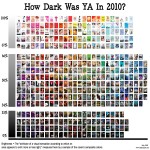OK, I’ll admit it. When I was in school (and college and grad school) I was seriously guilty of turning in work before revising it. Sure, I would do a quick spell-check and maybe give it a once-over for grammar, but rarely did I ever roll up my sleeves and do serious revision.
Now that I have a draft of my book done, I find myself in the middle of the revision process and I totally realize why I was resistant to revision before: it’s flippin’ scary. This is why I was so thrilled to hear James Scott Bell speak about the revision process at the Writer’s Digest Conference. I was particularly excited to attend his talk because I am a huge fan of his book The Art of War for Writers. Here are some of the sparkly nuggets I took away from this session.
Principles of Revision
1) Write hot, revise cool. Revision allows you to add rational choices and strategy to the frantic bursts of creativity that came out in the first draft. Take at least two weeks (maybe longer) after writing your draft to let it cool down before you revise.
2) You need to finish first. Nothing you write is etched in stone… you can always come back and make it better later on. The only thing you can’t do is revise a blank page. Finish first.
3) Do a first read-through. Try to recreate a reading experience so that you’re not focused on the fact that you’re reading your own book. Make minimal notes. Tip from Gabi: I put my book on my Kindle and have been reading it there so that it feels more like a “real book” and not just a draft on printed computer pages. I use the footnote function on the Kindle to make my notes, and since I’m lazy about taking notes on Kindle, it forces me to make my notes short.
4) Summarize your changes. Write a 2000 word summary of your draft with the new adjustments you just noted. Tip from Gabi: You can also try extracting an outline from the first draft, as a way of getting a handle on what you have written. Then adjust the outline according to the notes you made in your read-through and implement those changes in the draft.
Things to Think About in Revision
Character: The characters need to jump off the page. Here are a few exercises to help you with this:
- Try creating some “off-screen” scenes where you see what the character would do in crazy situations.
- Do the “opposite exercise” where you have the character do the opposite of what you’d expect, then figure out why they did that.
Remember, even at the very beginning, try to give the reader an inkling that the character has the potential for change.
Opening: As Bell put it: “Cut out the parts that people skip.” Start the story where things get interesting. Also, make trouble for your characters from the start. Readers become engaged with the characters at the first sign of conflict.
Dialogue: Compress the dialogue and extend the action. Get rid of exposition and ramp up the conflict. Even if characters are on the “same side” they should still have some kind of conflict between them.
Take-Home Message
Ultimately, revision is where you add the strategic element to your story. Now that you know who the characters are and what’s going to happen, you can plant foreshadowing moments and hint at themes that will be important later on. You can’t do all this in your first draft because during that stage of the process you don’t know your characters or the story completely. It’s only once you know the ending and who your characters are at their core that you can manipulate the story in a strategic way.
Much as my brain understands all the amazing benefits of revision, I still find myself having trouble because I keep psyching myself out.
Help! Do you have any revision tips I can borrow?







 Call me Gabi (pronounced gah-BEE). I'm a writer, freelance teacher, and a lover of books and words. I'm also the instigator of DIY MFA. iggi's my sidekick, but he thinks he's the brains behind this operation.
Call me Gabi (pronounced gah-BEE). I'm a writer, freelance teacher, and a lover of books and words. I'm also the instigator of DIY MFA. iggi's my sidekick, but he thinks he's the brains behind this operation.
 Goodbye is for Sissies
Goodbye is for Sissies YA Cafe: What YA Book are You Thankful For?
YA Cafe: What YA Book are You Thankful For? YA Cafe: Why I Love Dark YA
YA Cafe: Why I Love Dark YA YA Cafe: YA Appreciation Month
YA Cafe: YA Appreciation Month
Comments on this post
Love the summary idea … hadn't thought of it! Thanks!
EJW
16. February - 1:50 pmThis is great. I'm not to the revision state yet, but I'm going to refer back to this when I am. Although I've written three books, after spending a significant amount of time on blogspot, reading other writers going through the "revision process" I am realizing that I have never actually rolled up my sleeves and really revised anything. So I've been getting progressively more scared of it. This helps a lot!
16. February - 3:01 pmJames Scott Bell has such great advice. Thanks for sharing! I will definitely keep these tips in mind when I get to the revision stage.
16. February - 3:48 pmI revise by making to-do lists, both specific to my plot, and to general revision: http://writersblocknz.weebly.com/editors-block-tips.html
It probably only works for people who are "creatively analytical" though because it's an extremely structured way to work!
16. February - 8:27 pmWrote my first draft during NaNo. Let it cool in the drawer for a month. Picked it back up and spent a week on the first five chapters, then got totally overwhelmed. Put it away again, hoping the chapters would align themselves while I was away. No such luck. I'm peeking at it as we speak…thanks for the advice. I'm going to try the summary
16. February - 10:10 pmI've got several books by Mr. Bell. They are great. I will be walking through my first revision in about 30 days. *gulp*
17. February - 3:18 amThanks all for the great comments! I have to say, after hearing Mr. Bell speak, I'm an even bigger fan than before.
WritersBlockNZ — Wow! What an amazing post on editing. I definitely will need to go back to it when I have more time to soak it all in. Thanks for posting the link.
Parrot Writes and Kari Marie — Good luck with the editing! I feel your pain and can definitely relate. If you hit the wall and need to vent, you can find me on twitter. 🙂 @iggiandgabi
17. February - 3:37 am